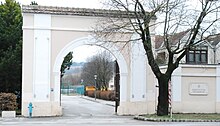Göllersdorf Prison
The Göllersdorf Prison is a special institution of the Austrian penal system. The prison is located in the municipality of Göllersdorf in Lower Austria . The institution has a special position among the Austrian prisons because it is the only institution with a mandate to treat mentally abnormal lawbreakers who are not responsible. In this sense, which is in the prison Gollersdorf correctional according to § 21 1 StGB or § 164 StVG completed.
Conception
The institution currently has an occupancy capacity of 120 prison places, which are given in bed places as in psychiatric hospitals. In addition to these 120 detainees, there are usually up to 29 prisoners who act as “system maintainers” and are assigned tasks such as kitchen service and labor. The prison is divided into six residential wards, each with 20 beds available. There is also an intensive care unit with a capacity of 17 beds.
As of March 13, 2009, 26 percent of the 120 or so men were in prison for bodily harm, 19 percent for sexual offenses, 17 percent for committed or attempted homicides, a further 17 percent for property crimes, 13 percent for arson and 8 percent for other crimes such as coercion or dangerous threat.
staff
The medical supervision is carried out by a senior specialist and his representative, both of whom are full-time employees of the prison. There are also 4.5 medical positions (9 half-time employees), 3.5 psychologists , 3.5 occupational therapists and a music therapist. In addition, 4 social workers and 34 nursing staff look after the prisoners. The institution also employs 1 general practitioner , a dentist and a pastor with an hourly obligation.
There is also the executive area, which is managed by the head of the institution and his deputy and implemented by a total of 55 prison guards . In addition, 15 office staff are available to the management of the institution.
history
The prison is housed in the building of Schloss Göllersdorf, a Renaissance building from the 16th century, which, however, still contains essential elements from around 1460. It had been in the possession of the Puchheim family since the 14th century. The Göllersdorf Castle becomes historically significant through the contract between Emperor Ferdinand II and Wallenstein (" Agreement of Göllersdorf ") concluded here on April 14, 1632 at a meeting between Albrecht von Wallenstein and the Imperial First Minister Johann Ulrich von Eggenberg was reinstated as commander in chief of the imperial army. The two had met here halfway between Vienna and Wallenstein's headquarters in Znojmo . The host and mediator was the lord of the castle, Field Marshal Johann Christoph III. Count of Puchheim.
In 1711, Melchior Friedrich Graf von Schönborn-Buchheim acquired the lords of Göllersdorf, Mühlberg and Aspersdorf through purchase and adoption . His son Friedrich Carl von Schönborn commissioned the architect Johann Lukas von Hildebrandt to convert the Mihlberg Fortress, which was on the property, into a representative country palace (1711–1718), which is still owned by the Schönborn family today . During the First World War , Göllersdorf Castle served as an internment camp for politically unreliable people. It was then used as a military and civil prison, as a federal educational institution and finally as a workhouse . With the criminal law reform of July 11, 1974, however, this form of detention was no longer available. The building was then acquired by the Federal Ministry of Justice from the Schönborn family and converted into a special institution for mentally abnormal lawbreakers. The newly renovated Göllersdorf Prison was finally given its current purpose in 1985.
On April 4, 1995, the psychotherapist Veronika Kreuziger-Hitz was murdered in the Göllersdorf prison by Franz Stockreiter, who had been sentenced to life imprisonment (Franz Stockreiter was in preparation for his release from prison), which led to a changed focus. While up to now in the therapeutic area the main focus was on confidentiality, the consideration of a therapist-client relationship that was as undisturbed as possible, now the protection of members of the care services and increased surveillance by prison guards are the top priorities. This is done, depending on the local conditions, by optical monitoring or with the help of personal emergency call devices. In the event of structural changes, it will also be planned in future that the rooms in which therapy sessions are to take place are located in the vicinity of rooms in which officers from the prison guard are regularly present.
Web links
- Website of the Göllersdorf Prison in the Justice Department.
Individual evidence
- ↑ Bettina Stimeder: Housed instead of locked up in the Göllersdorf prison . Article in the daily newspaper Der Standard on March 13, 2009.
- ↑ Entry about Schloss Göllersdorf at NÖ-Burgen online - Institute for Reality Studies of the Middle Ages and Early Modern Times, University of Salzburg
- ↑ Inquiry response (PDF; 39 kB) from the Federal Minister of Justice on the subject of the consequences of incidents in the Austrian penal institutions .
Coordinates: 48 ° 29 ′ 39.6 ″ N , 16 ° 7 ′ 17.6 ″ E


